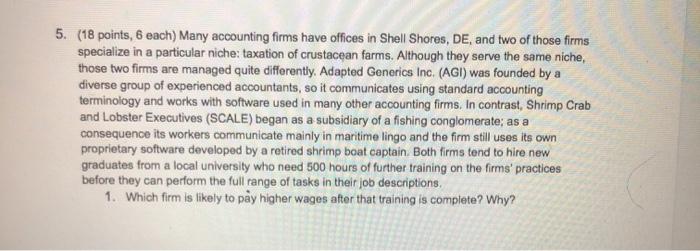5. (18 points, 6 each) Many accounting firms have offices in Shell Shores, DE, and two of those firms specialize in a particular niche: taxation of crustacean farms. Although they serve the same niche, those two firms are managed quite differently, Adapted Generics Inc. (AGI) was founded by a diverse group of experienced accountants, so it communicates using standard accounting terminology and works with software used in many other accounting firms. In contrast, Shrimp Crab and Lobster Executives (SCALE) began as a subsidiary of a fishing conglomerate; as a consequence its workers communicate mainly in maritime lingo and the firm still uses its own proprietary software developed by a retired shrimp boat captain Both firms tend to hire new graduates from a local university who need 500 hours of further training on the firms' practices before they can perform the full range of tasks in their job descriptions 1. Which firm is likely to pay higher wages after that training is complete? Why? 2. Discuss how the two firms are able to pay for the cost of that training. Note any important differences between them. 3. Which firm is more likely to adjust the size of its workforce during a (temporary) recession that reduces the demand for their services equally? Explain briefly 5. (18 points, 6 each) Many accounting firms have offices in Shell Shores, DE, and two of those firms specialize in a particular niche: taxation of crustacean farms. Although they serve the same niche, those two firms are managed quite differently, Adapted Generics Inc. (AGI) was founded by a diverse group of experienced accountants, so it communicates using standard accounting terminology and works with software used in many other accounting firms. In contrast, Shrimp Crab and Lobster Executives (SCALE) began as a subsidiary of a fishing conglomerate; as a consequence its workers communicate mainly in maritime lingo and the firm still uses its own proprietary software developed by a retired shrimp boat captain Both firms tend to hire new graduates from a local university who need 500 hours of further training on the firms' practices before they can perform the full range of tasks in their job descriptions 1. Which firm is likely to pay higher wages after that training is complete? Why? 2. Discuss how the two firms are able to pay for the cost of that training. Note any important differences between them. 3. Which firm is more likely to adjust the size of its workforce during a (temporary) recession that reduces the demand for their services equally? Explain briefly








